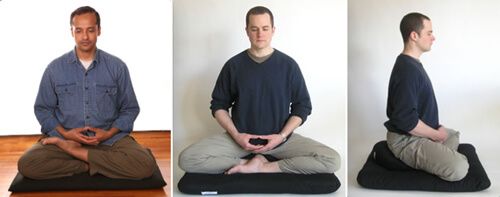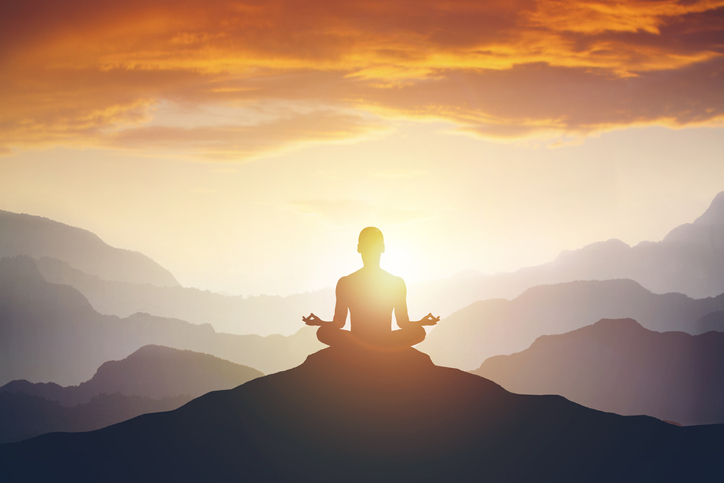
Vipassana Meditation
Vipassana was taught in India more than 2500 years ago as a universal remedy for universal ills, i.e., an Art of Living.
In Pali, an ancient language of Buddhism, the word “Vipassana” means “seeing things as they really are.” The literal translation is “special seeing.”
Often, the term “Vipassana meditation” is used interchangeably with “mindfulness meditation,” but Vipassana is more specific. It involves observing your thoughts and emotions as they are, without judging or dwelling on them.
Vipassana, you simply observe your inner self instead of consciously controlling the experience. The goal is to help you:

- Quiet your mind
- Focus on the present
- Accept thoughts, emotions, and sensations for what they really are
- Reduce regrets by dwelling less on the past
- Worry less about the future
- Respond to situations based on reality, instead of worries or preconceived notions
Why it is better for a beginner?
Vipassana is a kind of meditation that doesn’t need much preparation to be done and it is a good starting point for a beginner because it is really easy to follow and to achieve.
That means that the guide for this kind of meditation can be optional. An app will be useful for the timer, sounds and in case of guide a guide. You can follow these steps to try to do it on your own.
- Set aside 10 to 15 minutes to practice. It’s recommended that you do Vipassana when you first wake up in the morning.
- Choose a quiet area with little to no distractions.
- Sit in a comfortable position. Engage your core, straighten your back, and relax your body.
- Close your eyes and breathe normally. Focus on your natural breath and what you feel.
- Be mindful of each inhale and exhale. Observe your thoughts, feelings, and sensations without reacting or judging.
- If you become distracted, simply observe the distraction and return to your breath.
- Aim to do this for at least 5 to 10 minutes when you first start. As you get used to this practice, work up to 15 minutes or longer of Vipassana meditation.
Zen Meditation (Zazen)
Origin & Meaning
Zazen (坐禅) means “seated Zen”, or “seated meditation”, in Japanese. It has its roots in the Chinese Zen Buddhism (Ch’an) tradition, tracing back to the Indian monk Bodhidharma (6th century CE). In the West, its most popular form comes from Dogen Zenji (1200~1253), the founder of the Soto Zen movement in Japan. Similar modalities are practised in the Rinzai school of Zen, in Japan and Korea.
How to do it
It is generally practised seated on the floor over a mat and cushion, with crossed legs. Traditionally it was done in the so-called lotus or half-lotus position, but this is hardly necessary. Nowadays most practitioners sit like this:

Vipassana Meditation
Origin & Meaning
“Vipassana” is a Pali word tha

t means “insight” or “clear seeing”. It is a traditional Buddhist practice, dating back to 6th century BC. Vipassana-meditation, as taught in the last few decades, comes from the Theravada Buddhist tradition, and was popularized by S. N. Goenka and the Vipassana movement.
Due to the popularity of Vipassanā-meditation, the “mindfulness of breathing” has gained further popularity in the West as “mindfulness”.
How to do it
[There is some conflicting information on how to practice Vipassana. In general, however, most teachers emphasize starting with mindfulness of breath in the first stages, to stabilize the mind and achieve “access concentration.” This is more like focused attention meditation. Then the practice moves on to developing “clear insight” on the bodily sensations and mental phenomena, observing them moment by moment and not clinging to any. Here goes an introduction, aimed at beginners. To know more I’d suggest following up the links provided or learning from a teacher (perhaps in a Vipassana retreat).]
Ideally, one is to sit on a cushion on the floor, cross-legged, with your spine erect; alternatively, a chair may be used, but the back should not be supported.
The first aspect is to develop concentration, through samatha practice. This is typically done through breathing awareness.
Focus all your attention, from moment to moment, on the movement of your breath. Notice the subtle sensations of the movement of the abdomen rising and falling. Alternatively, one can focus on the sensation of the air passing through the nostrils and touching the upper lips skin – though this requires a bit more practice, and is more advanced.
As you focus on the breath, you will notice that other perceptions and sensations continue to appear: sounds, feelings in the body, emotions, etc. Simply notice these phenomena as they emerge in the field of awareness, and then return to the sensation of breathing. The attention is kept in the object of concentration (the breathing), while these other thoughts or sensations are there simply as “background noise”.
The object that is the focus of the practice (for instance, the movement of the abdomen) is called the “primary object”. And a “secondary object” is anything else that arises in your field of perception – either through your five senses (sound, smell, itchiness in the body, etc.) or through the mind (thought, memory, feeling, etc.). If a secondary object hooks your attention and pulls it away, or if it causes the desire or aversion to appearing, you should focus on the secondary object for a moment or two, labelling it with a mental note, like “thinking”, “memory”, “hearing”, “desiring”. This practice is often called “noting”.
A mental note identifies an object in general but not in detail. When you’re aware of a sound, for example, label it “hearing” instead of “motorcycle,” “voices” or “barking dog.” If an unpleasant sensation arises, note “pain” or “feeling” instead of “knee pain” or “my back pain.” Then return your attention to the primary meditation object. When aware of a fragrance, say the mental note “smelling” for a moment or two. You don’t have to identify the scent.
When one has thus gained “access concentration”, the attention is then turned to the object of practice, which is normally thought or bodily sensations. One observes the objects of awareness without attachment, letting thoughts and sensations arise and pass away of their own accord. Mental labelling (explained above) is often used as a way to prevent you from being carried away by thoughts, and keep you in more objectively noticing them.
As a result one develops the clear seeing that the observed phenomena are pervaded by the three “marks of existence”: impermanence (annica), unsatisfactoriness (dukkha) and emptiness of self (annata). As a result, equanimity, peace and inner freedom are developed in relation to these inputs.
Loving Kindness Meditation (Metta Meditation)
Origin & Meaning

Metta is a Pali word that means kindness, benevolence, and goodwill. This practise comes from the Buddhist traditions, especially the Theravada and Tibetan lineages. “Compassion meditation” is a contemporary scientific field that demonstrates the efficacy of metta and related meditative practices.
Demonstrated benefits include: boosting one’s ability to empathize with others; development of positive emotions through compassion, including a more loving attitude towards oneself; increased self-acceptance; greater feeling of competence about one’s life; and an increased feeling of purpose in life (read more in our other post).
How to do it
One sits down in a meditation position, with closed eyes, and generates in his mind and heart feelings of kindness and benevolence. Start by developing loving-kindness towards yourself, then progressively towards others and all beings. Usually this progression is advised:
- oneself
- a good friend
- a “neutral” person
- a difficult person
- all four of the above equally
- and then gradually the entire universe
The feeling to be developed is that of wishing happiness and well-being for all. This practice may be aided by reciting specific words or sentences that evoke the “boundless warm-hearted feeling”, visualizing the suffering of others and sending love; or by imagining the state of another being, and wishing him happiness and peace.
Mantra Meditation (OM Meditation)
Origin & Meaning

A mantra is a syllable or word, usually without any particular meaning, that is repeated for the purpose of focusing your mind. It is not an affirmation used to convince yourself of something.
Some meditation teachers insist that both the choice of word, and its correct pronunciation, is very important, due to the “vibration” associated with the sound and meaning, and that for this reason, an initiation into it is essential. Others say that the mantra itself is only a tool to focus the mind, and the chosen word is completely irrelevant.
Mantras are used in Hindu traditions, Buddhist traditions (especially Tibetan and “Pure Land” Buddhism), as well as in Jainism, Sikhism and Daoism (Taoism). Some people call mantra meditation “om meditation”, but that is just one of the mantras that can be used. A more devotion oriented practice of mantras is called japa, and consists of repeating sacred sounds (name of God) with love.
How to do it
Like with most types of meditations, it is usually practised sitting with spine erect, and eyes closed. The practitioner then repeats the mantra in his mind, silently, over and over again during the whole session.
Sometimes this practice is coupled with being aware of the breathing or coordinating with it. In other exercises, the mantra is actually whispered very lightly and softly, as an aid to concentration.
As you repeat the mantra, it creates a mental vibration that allows the mind to experience deeper levels of awareness. As you meditate, the mantra becomes increasingly abstract and indistinct, until you’re finally led into the field of pure consciousness from which the vibration arose.
Repetition of the mantra helps you disconnect from the thoughts filling your mind so that perhaps you may slip into the gap between thoughts. The mantra is a tool to support your meditation practice. Mantras can be viewed as ancient power words with subtle intentions that help us connect to spirit, the source of everything in the universe. (Deepak Chopra)
OM is a well-known example of a mantra. But there are thousands of others. Here are some of the most well-known mantras from the Hindu & Buddhist traditions:
- om
- so-ham
- om namah shivaya
- om mani padme hum
- rama
- yam
- ham
You may practice for a certain period of time, or for a set number of “repetitions” – traditionally 108 or 1008. In the latter case, beads are typically used for keeping count.
As the practice deepens, you may find that the mantra continues “by itself” like the humming of the mind. Or the mantra may even disappear, and you are left in a state of deep inner peace.
There are many methods of mantra meditation. I explain them in detail, together with why mantras are powerful, in my article on mantra meditation.
Yogic Meditations
Origin & Meaning

There is no one type of meditation which is “Yogic Meditation”, so here it is meant the several meditation types taught in the yoga tradition. Yoga means “union”. The tradition goes as far as 1700 B.C, and has as its highest goal spiritual purification and Self-Knowledge. Classical Yoga divides the practice into rules of conduct (yamas and niyamas), physical postures (asanas), breathing exercises (pranayama), and contemplative practices of meditation (pratyahara, dharana, dhyana, samadhi).
The Yoga tradition is the oldest meditation tradition on earth, and also the one with the widest variety of practices.
How to do it
Here are some types of meditation practised in Yoga. The most common and universal Yoga meditation one is the “third eye meditation”. Other popular ones involve concentrating on a chakra, repeating a mantra, visualization of light, or gazing meditations.
- Third Eye Meditation — focusing the attention on the “spot between the eyebrows” (called by some “the third eye” or “ajna chakra”). The attention is constantly redirected to this point, as a means to silence the mind. By time the “silent gaps” between thoughts get wider and deeper. Sometimes this is accompanied by physically “looking”, with eyes closed, towards that spot.
- Chakra Meditation — the practitioner focuses on one of the seven chakras of the body (“centers of energy”), typically doing some visualizations and chanting a specific mantra for each chakra (lam, vam, ram, yam, ham, om). Most commonly it is done on the heart chackra, third eye, and crown chackra.
- Gazing Meditation (Trataka) — fixing the gaze on an external object, typically a candle, image or a symbol (yantras). It is done with eyes open, and then with eyes closed, to train both the concentration and visualization powers of the mind. After closing the eyes, you should still keep the image of the object in your “mind’s eye”.
- Kundalini Meditation — this is a very complex system of practice. The goal is the awakening of the “kundalini energy” which lies dormant on the base of the spine, the development of several psychic centers in the body, and, finally, enlightenment. There are several dangers associated with this practice, and it should not be attempted without the guidance of a qualified yogi.
- Kriya Yoga — is a set of energization, breathing, and meditation exercises taught by Paramahamsa Yogananda. This is more suited for those who have a devotional temperament, and are seeking the spiritual aspects of meditation.
- Sound Meditation (Nada Yoga) — focusing on sound. Starts with meditation on “external sounds”, such as calming ambient music (like Native American flute music), whereby the student focuses all his attention on just hearing, as a help to quieten and collect the mind. By time the practice evolves to hearing the “internal sounds” of the body and mind. The ultimate goal is to hear the “Ultimate Sound” (para nada), which is a sound without vibration, and that manifests as “OM”.
- Tantra — unlike the popular view in the West, most Tantra practices have nothing to do with ritualized sex (this was practiced by a minority of lineages. Tantra is a very rich tradition, with dozens of different contemplative practices. The text Vijnanabhairava Tantra, for instance, lists 108 “meditations”, most of them more advanced (already requiring a certain degree of stillness and mind control). Here are some examples from that text:
- Merge the mind and the senses in the interior space in the spiritual heart.
- When one object is perceived, all other objects become empty. Concentrate on that emptiness.
- Concentrate on the space which occurs between two thoughts.
- Fix attention on the inside of the skull. Close eyes.
- Meditate on the occasion of any great delight.
- Meditate on the feeling of pain.
- Dwell on the reality which exists between pain and pleasure.
- Meditate on the void in one’s body extending in all directions simultaneously.
- Concentrate on a bottomless well or as standing in a very high place.
- Listen to the Anahata [heart chakra] sound.
- Listen to the sound of a musical instrument as it dies away.
- Contemplate on the universe or one’s own body as being filled with bliss.
- Concentrate intensely on the idea that the universe is completely void.
- Contemplate that the same consciousness exists in all bodies.
- Pranayama — breathing regulation. It is not exactly meditation, but an excellent practice to calm the mind and prepare it for meditation. There are several different types of Pranayama, but the simplest and most commonly taught one is the 4-4-4-4. This means breathing in counting up to 4, holding for 4 seconds, breathing out for 4 seconds, and holding empty for 4 seconds. Breathe through your nose, and let the abdomen (and not the chest) be the one that moves. Go through a few cycles like this. This regulation of breathing balances the moods and pacifies the body, and can be done anywhere.
Yoga is a very rich tradition, with different lineages, so there are many other techniques. But the ones above are the most well-known; the others are more specific or complex.
Sources:
https://www.healthline.com/health/mental-health/types-of-meditation

